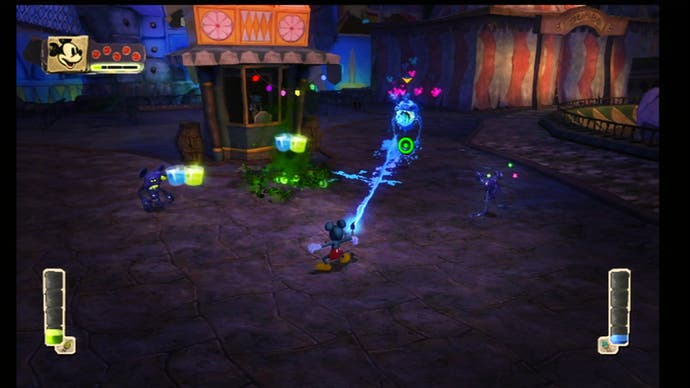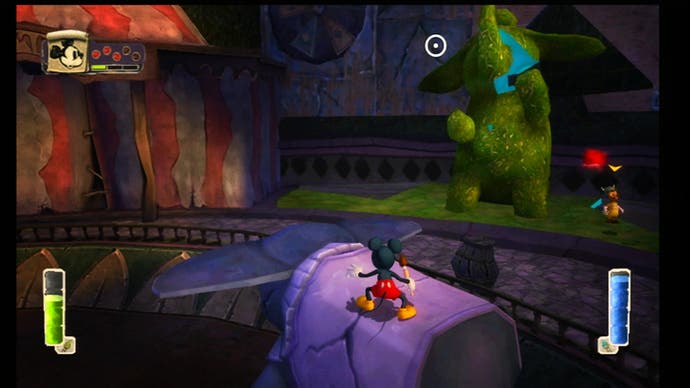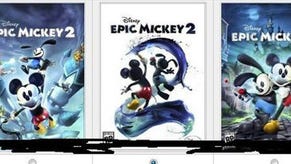Disney Epic Mickey
The ink crowd.
Reinvigorating the most widely recognised pop culture icon in the world is no mean feat. That Disney has chosen to reintroduce Mickey Mouse to the world through videogames rather than movies or TV should feel like a welcome validation of our beloved medium, but I can't shake the suspicion that it's also the safest route to take.
If it works, Disney looks innovative and forward thinking, and Mickey Mouse becomes a vibrant, active character again, not just a face on a t-shirt. But if it doesn't work, games are still distant enough from movies and TV that the result can be swept under the rug as a failed experiment. Certainly, Disney Epic Mickey has apparently benefited from the most laissez-faire use of the Mickey brand that Disney has endorsed.
It's curious, then, that so much of Epic Mickey feels overly familiar and not particularly memorable. This is a game that has arrived on the back a year of hype, promising the ultimate Disney game, the most important third-party Wii game, the most radical reinvention of Mickey that fans have ever seen.

As Flavor Flav so sagely advised us, don't believe the hype. What you actually get is the Mickey you expect in a 3D platformer that feels very much like it belongs in 1999. That's not really a criticism, since some of the best examples of the genre hail from that era, but it sits awkwardly with the bold claims of innovation made on the game's behalf.
At its best, Epic Mickey plays like a Disneyfied spin on Banjo Kazooie, offering multiple pathways through an interconnected world. At its lowest points, as you scramble around uninspiring environments hunting for items, you might as well be playing Gex: Enter the Gecko.
The story is that Mickey is lured into an alternate world where unloved and forgotten Disney characters and concepts reside. Oswald the Lucky Rabbit is the bitter ruler of this place, an early Walt creation who predates Mickey and was swiftly abandoned once the mouse began his inexorable ascent to celebrity.
Oswald has turned his world into a bitter reflection of Mickey's domain, with miserable echoes of Disneyland locations and animatronic copies of Mickey's pals. Forlorn sepia cows mope about, trying to make the best of their depressed landscape, now made even worse by the invasion of the Phantom Blot, a destructive inky force unleashed by Mickey's clumsiness.

Control is much as you'd expect, given the genre. The nunchuk controls movement, the A button is for all your double-jumping needs, while a shake triggers a spin attack. Pointing the remote allows you to use the triggers on both controllers to direct a stream of either paint or thinner into the game world.
It's this mechanism that drives most of the environmental puzzles, as you're able to erase objects from existence or paint them back again. When the game bothers to play around with this concept, the results are memorable and clever. Wiping away the floor so that an obstacle drops into the abyss, before painting it back to cross safely, is one example of the options the paint and thinner system opens up. It's a shame that such moments are relatively rare though. For the most part, you're painting in obvious platforms to reach the next area, or simply filling in blanks in the game world because you can.
At all times, your decorating efforts are hampered by a fairly wretched camera – another throwback to the late-nineties genre staples, though this time not quite as welcome. Mickey has an irritating habit of squirting his magic goo all over his shoes, rather than the ground in front of him where you're aiming, and there's a lot of carefully inching towards deadly drops until the game relents and agrees that, yes, Mickey can now see what's in front of him and fill that ghostly platform.
The camera also blights the more perilous platforming sections, struggling to keep pace as you climb and drop, and it's an absolute pain during combat. Enemies can be destroyed or befriended, depending on whether you use thinner or paint on them, but that's only if you can keep them in view. There's a clunky lock-on system, but the camera still leaves you exposed in close quarters. Mickey often vanishes from the screen completely, or you're left staring at a corner, hoping you're not about to fall into a hole and die.




